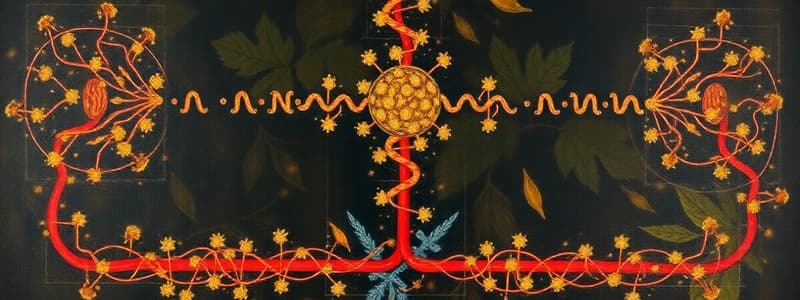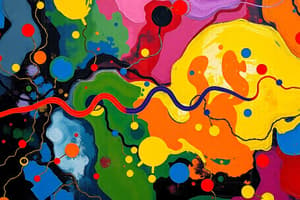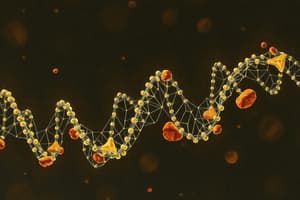Podcast
Questions and Answers
What is the process by which cells convert free energy from nutrients into ATP called?
What is the process by which cells convert free energy from nutrients into ATP called?
- Metabolism
- Anabolism
- Respiration
- Catabolism (correct)
Which term describes the removal of electrons in a biochemical reaction?
Which term describes the removal of electrons in a biochemical reaction?
- Hydrolysis
- Reduction
- Phosphorylation
- Oxidation (correct)
What is the role of oxygen in respiration?
What is the role of oxygen in respiration?
- To serve as the final electron acceptor (correct)
- To act as a catalyst for all reactions
- To facilitate transport of nutrients
- To provide energy directly to cells
Which enzymes are specifically responsible for reactions that do not involve molecular O2?
Which enzymes are specifically responsible for reactions that do not involve molecular O2?
What condition is indicated by insufficient oxygen availability at the tissue level?
What condition is indicated by insufficient oxygen availability at the tissue level?
What is the effect of feedback inhibition on PFK-1 in glycolysis?
What is the effect of feedback inhibition on PFK-1 in glycolysis?
Which compound is NOT an inhibitor of the electron transport chain?
Which compound is NOT an inhibitor of the electron transport chain?
What happens to electron carriers when the electron transport chain is blocked?
What happens to electron carriers when the electron transport chain is blocked?
Which of the following processes produces the most ATP?
Which of the following processes produces the most ATP?
What is the primary role of the electron transport chain in cellular metabolism?
What is the primary role of the electron transport chain in cellular metabolism?
Which of the following molecules donates electrons during oxidative phosphorylation?
Which of the following molecules donates electrons during oxidative phosphorylation?
What is the main purpose of the electron transport chain in oxidative phosphorylation?
What is the main purpose of the electron transport chain in oxidative phosphorylation?
Where does oxidative phosphorylation mainly occur in animal cells?
Where does oxidative phosphorylation mainly occur in animal cells?
What does the chemiosmotic theory suggest is necessary for ATP synthesis?
What does the chemiosmotic theory suggest is necessary for ATP synthesis?
In biological oxidation, the role of intracellular enzymes is primarily to:
In biological oxidation, the role of intracellular enzymes is primarily to:
What do the proteins in the electron-transport chain primarily create?
What do the proteins in the electron-transport chain primarily create?
Which of the following statements about energy production is true?
Which of the following statements about energy production is true?
What is the relation between NADH, FADH2, and ATP in oxidative phosphorylation?
What is the relation between NADH, FADH2, and ATP in oxidative phosphorylation?
Which of the following complexes is NOT involved in actively transporting protons across the membrane?
Which of the following complexes is NOT involved in actively transporting protons across the membrane?
What is the role of cytochromes in the electron-transport chain?
What is the role of cytochromes in the electron-transport chain?
The coupling of electron transport and ATP synthesis is primarily driven by:
The coupling of electron transport and ATP synthesis is primarily driven by:
Which molecule is reduced during the process of electron transport at Complex II?
Which molecule is reduced during the process of electron transport at Complex II?
What role does the inner membrane of mitochondria play in ATP synthesis?
What role does the inner membrane of mitochondria play in ATP synthesis?
Which compartment of the mitochondrion is characterized by a lower proton concentration?
Which compartment of the mitochondrion is characterized by a lower proton concentration?
What is the main consequence of the proton-motive force established by the electron transport chain?
What is the main consequence of the proton-motive force established by the electron transport chain?
What is required for the proton gradient in chemiosmotic energy coupling?
What is required for the proton gradient in chemiosmotic energy coupling?
How does ATP synthesis relate to electron transport?
How does ATP synthesis relate to electron transport?
What is a defining feature of ATP synthase?
What is a defining feature of ATP synthase?
Which of the following correctly describes the outer membrane of the mitochondrion?
Which of the following correctly describes the outer membrane of the mitochondrion?
Which of the following forms of energy is primarily involved in photosynthesis?
Which of the following forms of energy is primarily involved in photosynthesis?
What are flavin mononucleotide (FMN) and flavin adenine dinucleotide (FAD) in the context of electron transport?
What are flavin mononucleotide (FMN) and flavin adenine dinucleotide (FAD) in the context of electron transport?
What increase in the inner mitochondrial membrane structure assists in ATP production?
What increase in the inner mitochondrial membrane structure assists in ATP production?
The chemiosmotic theory posits that ATP synthesis is coupled to which of the following?
The chemiosmotic theory posits that ATP synthesis is coupled to which of the following?
What type of environment does the intermembrane space (IMS) of mitochondria have compared to the cytosol?
What type of environment does the intermembrane space (IMS) of mitochondria have compared to the cytosol?
What is the primary role of the F0 unit of mitochondrial ATP synthase?
What is the primary role of the F0 unit of mitochondrial ATP synthase?
How does the IF1 protein protect the cell during hypoxia?
How does the IF1 protein protect the cell during hypoxia?
Which biochemical process is primarily regulated by the availability of NADH and ADP/Pi?
Which biochemical process is primarily regulated by the availability of NADH and ADP/Pi?
What occurs when oxygen is limiting in mitochondrial function?
What occurs when oxygen is limiting in mitochondrial function?
In which tissues does the malate-aspartate shuttle primarily operate?
In which tissues does the malate-aspartate shuttle primarily operate?
What form of reactive oxygen species is converted into H2O2 by superoxide dismutase?
What form of reactive oxygen species is converted into H2O2 by superoxide dismutase?
What is a consequence of inhibited oxidative phosphorylation?
What is a consequence of inhibited oxidative phosphorylation?
What is the role of glutathione peroxidase in the context of oxidative stress?
What is the role of glutathione peroxidase in the context of oxidative stress?
Flashcards
Catabolism
Catabolism
A process where cells use free energy stored in nutrients to create ATP (adenosine triphosphate), the primary energy currency of cells.
Anabolism
Anabolism
A process where cells use energy from ATP to build complex molecules, like proteins and carbohydrates.
Biological Oxidation
Biological Oxidation
The transfer of electrons from one molecule to another. Oxidation is the loss of electrons, and reduction is the gain of electrons.
Dehydrogenases
Dehydrogenases
Signup and view all the flashcards
Hypoxia
Hypoxia
Signup and view all the flashcards
Enzymes in Oxidation-Reduction Reactions
Enzymes in Oxidation-Reduction Reactions
Signup and view all the flashcards
Electron Carriers
Electron Carriers
Signup and view all the flashcards
Electron Transport Chain
Electron Transport Chain
Signup and view all the flashcards
Oxidative Phosphorylation
Oxidative Phosphorylation
Signup and view all the flashcards
Chemiosmotic Theory
Chemiosmotic Theory
Signup and view all the flashcards
ATP Synthesis
ATP Synthesis
Signup and view all the flashcards
Reduced Cofactors (NADH, FADH2)
Reduced Cofactors (NADH, FADH2)
Signup and view all the flashcards
Cytochromes
Cytochromes
Signup and view all the flashcards
Mitochondrial Complexes
Mitochondrial Complexes
Signup and view all the flashcards
Electron-Transport Chain (ETC)
Electron-Transport Chain (ETC)
Signup and view all the flashcards
Chemiosmotic Energy Coupling
Chemiosmotic Energy Coupling
Signup and view all the flashcards
Complex I
Complex I
Signup and view all the flashcards
Outer Membrane of Mitochondrion
Outer Membrane of Mitochondrion
Signup and view all the flashcards
Complex II
Complex II
Signup and view all the flashcards
Complex III
Complex III
Signup and view all the flashcards
Intermembrane Space (IMS) of Mitochondrion
Intermembrane Space (IMS) of Mitochondrion
Signup and view all the flashcards
Complex IV
Complex IV
Signup and view all the flashcards
Inner Membrane of Mitochondrion
Inner Membrane of Mitochondrion
Signup and view all the flashcards
Matrix of Mitochondrion
Matrix of Mitochondrion
Signup and view all the flashcards
Forms of Energy
Forms of Energy
Signup and view all the flashcards
Bioenergetics
Bioenergetics
Signup and view all the flashcards
IF1 (Inhibitor Protein)
IF1 (Inhibitor Protein)
Signup and view all the flashcards
ATPase
ATPase
Signup and view all the flashcards
Electron Transport Chain Inhibitors
Electron Transport Chain Inhibitors
Signup and view all the flashcards
ATP (Adenosine Triphosphate)
ATP (Adenosine Triphosphate)
Signup and view all the flashcards
Electron Carrier State in Inhibition
Electron Carrier State in Inhibition
Signup and view all the flashcards
Feedback Inhibition in Glycolysis
Feedback Inhibition in Glycolysis
Signup and view all the flashcards
PFK-1 Regulation
PFK-1 Regulation
Signup and view all the flashcards
Intermembrane Space (IMS)
Intermembrane Space (IMS)
Signup and view all the flashcards
Electron Transport Chain Function
Electron Transport Chain Function
Signup and view all the flashcards
Study Notes
Oxidative Phosphorylation Overview
- Oxidative phosphorylation is a process where energy from reduced fuels, such as carbohydrates, lipids, and amino acids, produces ATP in animals.
- This process involves biological oxidation catalyzed by intracellular enzymes.
- Electrons from reduced fuels are transferred to reduced coenzymes NADH or FADH2.
- Oxidative phosphorylation couples electron transport (ETC) with ATP synthesis.
- This process occurs in the mitochondria.
Components of Oxidative Phosphorylation
- Biological oxidation: Involves electron transfer; oxidation is removal of electrons, reduction is gain of electrons. Oxidation is always accompanied by reduction of an electron acceptor.
- Electron carriers: Transfer electrons through a series of coenzymes (NAD+, FAD, FMN, FeS, ubiquinone, cytochromes). This sequence transfers electrons to oxygen.
- Mitochondrial transport system: A series of protein complexes (I-IV) in the inner mitochondrial membrane that facilitate electron transfer. This process generates a proton gradient.
- H+ transport: Protons are pumped across the inner mitochondrial membrane creating an electrochemical gradient, which is used to generate ATP.
Mitochondria Structure
-
Double membrane: The mitochondria have inner membrane with cristae. The outer membrane is relatively porous allowing passage of metabolites. This structure leads to different compartments for specific functions.
-
Intermembrane space: Similar environment to cytosol, but higher proton concentration (lower pH) than matrix.
-
Inner membrane: Relatively impermeable to establish a proton gradient, location of electron transport chain complexes, has folds called cristae to increase surface area.
-
Matrix: Has the location of the citric acid cycle, part of lipid and amino acid metabolism. It has a lower proton concentration (higher pH).
Chemiosmotic Theory
- ADP + Pi → ATP is not thermodynamically favorable.
- Energy is needed to phosphorylate ADP, which is provided by the flow of protons down an electrochemical gradient.
- Energy from electron transport is used to transport protons against the electrochemical gradient, creating a proton-motive force.
Electron-Transport Chain Complex Functions
- Each complex has multiple redox centers (flavin mononucleotide (FMN), flavin adenine dinucleotide (FAD), cytochromes, iron-sulfur clusters).
- Electrons flow from one complex to the next.
- Transport of electrons is coupled with proton pumping.
- The flow of protons creates an electrochemical gradient across the inner membrane.
ATP Synthase Function
- ATP synthase is a complex made of two functional units, F0 and F1.
- F0 is an integral membrane complex that allows protons to flow back across the inner mitochondrial membrane into the matrix.
- F1 is a soluble complex that utilizes the energy from the proton's flow to catalyze the phosphorylation of ADP to ATP.
Hypoxia
- Hypoxia is a state of insufficient oxygen supply at the tissue level.
- During hypoxia, the electron transport chain activity is reduced, which may lead to the accumulation of NADH and thus cause a feedback inhibition cascade to PFK-1 in glycolysis.
- The protein IF1 protects the cell from hypoxia-induced ATP hydrolysis..
Other details about Oxidative Phosphorylation
- The Malate-Aspartate shuttle and the Glycerol 3-phosphate shuttle move reducing equivalents across the mitochondrial membrane.
- Oxidative phosphorylation is regulated primarily by substrate availability (NADH, ADP, and Pi), and inhibitor of F1(IF1).
- The various complexes, the proton-motive force, and ATP synthase all play important roles in oxidative phosphorylation.
Studying That Suits You
Use AI to generate personalized quizzes and flashcards to suit your learning preferences.



